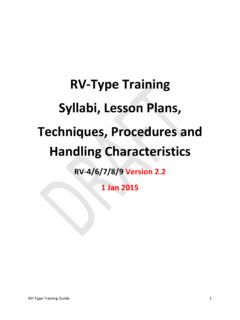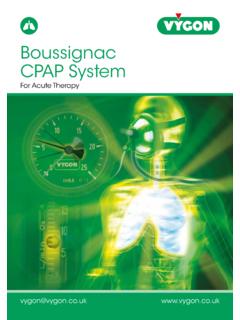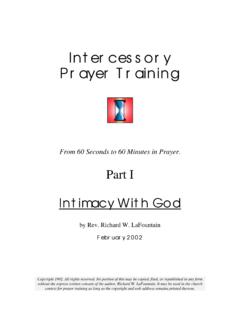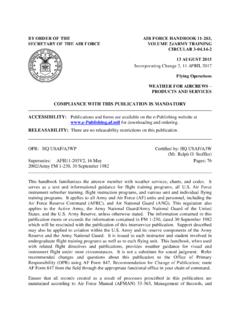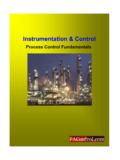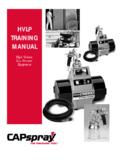Transcription of TURBULENCE - static.e-publishing.af.mil
1 DEPARTMENT OF THE AIR FORCE. WASHINGTON DC. AFMAN15-129 Vol2_AFGM2018-01. 26 June 2018. MEMORANDUM FOR DISTRIBUTION C. MAJCOMs/FOAs/DRUs FROM: HQ USAF/A3. SUBJECT: Air Force Guidance Memorandum AFMAN 15-129, Volume 2, Air and Space Weather Operations - Exploitation By Order of the Secretary of the Air Force, this Guidance Memorandum immediately implements changes to AFMAN 15-129, Volume 2, Air and Space Weather Operations . Exploitation. Compliance with this Memorandum is mandatory. To the extent its directions are inconsistent with other Air Force publications, the information herein prevails IAW AFI 33-360, Publications and Forms Management. Air Force guidance that directs how TURBULENCE is annotated on weather briefings, provided in AFMAN 15-129V2, dated 7 December 2011, is changed as follows: Paragraph is changed to read: TURBULENCE (not associated with thunderstorms). Enter the name and DTG of the TURBULENCE forecast product used ( , 557.)
2 WW/OWS products, NWS or foreign In-Flight Weather Advisories). Enter the type, intensity, levels, and locations of TURBULENCE affecting the route or specific mission. NOTE: If TURBULENCE is considered to be mountain wave TURBULENCE a mandatory remark will be made in Block 35 of the DD Form 175-1. The remark will read that mountain wave TURBULENCE is expected and include the altitudes. For example, Mountain wave TURBULENCE is expected from FL150-300 . This memorandum becomes void after one year has elapsed from the date of this memorandum, or upon publication of an Interim Change or rewrite of the affected publication, whichever is earlier. ROWAYNE A. SCHATZ, JR., SES, DAF. Associate DCS, Operations BY ORDER OF THE SECRETARY AIR FORCE MANUAL 15-129, OF THE AIR FORCE Volume 2. 7 DECEMBER 2011. Weather AIR AND SPACE WEATHER. OPERATIONS EXPLOITATION. COMPLIANCE WITH THIS PUBLICATION IS MANDATORY. ACCESSIBILITY: This publication is available digitally on the AFDPO WWW site at: RELEASABILITY: There are no releasability restrictions on this publication.
3 OPR: AF/A3O-W Certified by: AF/A3O. (Maj Gen Brett T. Williams). Supersedes: AFMAN15-129_AFGM, Pages: 75. 29 December 2010; AFMAN. 15-129, 21 June 2004. This manual implements Air Force Policy Directive (AFPD) 15-1, Air Force Weather Operations. This publication applies to all organizations in the US Air Force (USAF) with weather forces assigned, to include Air Force Reserve Command (AFRC), Air National Guard (ANG) and government-contracted weather operations if stated in the Statement of Work (SOW). or Performance Work Statement (PWS). This publication provides Air Force weather personnel and organizations guidance on how to accomplish operations for integration and exploitation as described in AFI 15-128, Air Force Weather Roles and Responsibilities and Army Regulation 115-10/AFJI 15-157 (IP), Weather Support for the US Army. Major commands (MAJCOMs), field operating agencies (FOAs) and direct reporting units (DRUs), send one copy of supplements to AF/A3O-W, 1490 Air Force Pentagon, Washington DC 20330-1490 for coordination.
4 Refer recommended changes and questions about this publication to the office of primary responsibility (OPR) using the AF Form 847, Recommendation for Change of Publication; route AF Form 847s from the field through the appropriate functional chain of command. MAJCOM Functionals, FOAs, and DRUs send one copy of implementing instructions to AF/A3O-WP, 1490 Air Force Pentagon, Washington, DC 20330-1490 for review and coordination. Ensure that all records created as a result of processes prescribed in this publication are maintained in accordance with (IAW) AFMAN 33-363, Management of Records and disposed of in accordance with the Air Force Records Disposition Schedule (RDS) located at This publication applies to AFRC. units and to the ANG. Effective use of the guidance and procedures in this manual will enhance 2 AFMAN15-129V2 7 DECEMBER 2011. the quality, timeliness, and relevance of air and space weather information, products, and services. In this manual, will and shall indicate mandatory requirements.
5 Should is used to indicate a preferred but not mandatory practice or method of accomplishment. May . indicates an acceptable or suggested method of accomplishment. SUMMARY OF CHANGES. This manual has been divided into two volumes and must be completely reviewed. Volume One contains information on overarching weather principles and weather characterization, Volume Two contains information concerning integration and exploitation of weather data. Guidance specific to the unique operations of Special Operations Weather Teams (SOWT) will be maintained in AFI 15-135, Special Operations Weather. Chapter 1 STAFF INTEGRATION FUNCTION 5. Weather Integration and Exploitation.. 5. Exploitation Units.. 5. Documentation.. 6. Table Example Duty Priorities (EU) .. 8. CU EU Documentation and Collaboration.. 11. Expeditionary Operations.. 13. Table Example Duty Priorities for Deployed/Expeditionary EUs .. 13. Support Assistance Request (SAR).. 14. KQ Identifiers.
6 14. Coordinated Weather Operations.. 16. Table Prioritized Rules for Determining the Lead Weather Unit .. 17. Table Lead Weather Unit for IFM Missions .. 19. COOP.. 19. CHAPTER 2 MISSION INTEGRATION FUNCTION 21. Mission Integration Function.. 21. Mission Weather Products (MWP).. 21. Mission Execution Forecast Process (MEFP).. 22. Table MEFP Administrative Processes .. 23. Table MEFP Operational Process .. 25. Flight Weather Briefings (FWB).. 25. Table Flight Weather Briefing References .. 27. Provide or Arrange for Support.. 27. AFMAN15-129V2 7 DECEMBER 2011 3. Flight Weather Briefing Documentation and Retention.. 28. Table illustrates an example of a locally developed Aircrew Briefing Log.. 29. Table Aircrew Briefing Log.. 29. Web-Based Aircrew Briefings.. 29. Air Mobility Command Weather Briefings.. 29. Table Integrated Flight Management standard mission-limiting criteria.. 30. Air Combat Command Air Operations Squadron (ACC AOS) Controlled Missions.
7 30. Pilot Reports (PIREPs) and Significant Meteorological Information (SIGMETs). 31. Tactical Decision Aids (TDA).. 31. Tropical Cyclone Products.. 31. Space Weather Products.. 32. Volcanic Ash.. 32. Chemical, Biological, Radiological, Nuclear and High-Yield Explosive (CBRNE). 32. Shift Change Briefings/Forecast Discussions.. 33. Mission-Scale Meteorological Watch (MISSIONWATCH).. 33. Table Basic MISSIONWATCH Steps .. 34. Weather Watch, Warning, and Advisory (WWA) Program.. 34. Severe Weather Action Plan (SWAP).. 35. Severe Weather Reporting (e.. 35. MWP Reviews.. 35. Chapter 3 AIRFIELD SUPPORT FUNCTION 37. Airfield Support Function.. 37. Flight Information Publication (FLIP) Review.. 37. Pilot-To-Metro-Service (PMSV).. 37. Figure Example PMSV Log .. 38. PIREPS.. 39. Aircraft/Ground Mishap Data Save.. 39. Collocated weather organizations.. 40. Airfield Operations Board (AOB).. 40. Chapter 4 SPECIALIZED SUPPORT OPERATIONS 41. Weather Support for Air and Space Operations Centers (AOC).)
8 41. Unmanned Aircraft Support.. 41. Table Group 4 and 5 RPA Weather Support Requirements .. 42. 4 AFMAN15-129V2 7 DECEMBER 2011. Weather Support to 618 AOC/Tanker Airlift Control Center (TACC).. 44. Weather Support to Air Combat Command Air Operations Squadron (ACC AOS). Missions.. 44. Space Weather Support Cooperation .. 44. Weather Support for Space Launch and Range Operations.. 45. Chapter 5 AIR FORCE WEATHER SYSTEMS 46. General Operating Procedures/Functions.. 46. Meteorological Equipment.. 46. Technical Assistance.. 46. Weather Radar (i.. 47. Pre-Deployment and Periodic Operations Checks/Inventories.. 48. Attachment 1 GLOSSARY OF REFERENCES AND SUPPORTING INFORMATION 49. Attachment 2 DD FORM 175-1, FLIGHT WEATHER BRIEFING INSTRUCTIONS 58. Attachment 3 INSTRUCTIONS FOR COMPLETING AF IMT 3807, WATCH/WARNING. NOTIFICATION AND VERIFICATION 65. Attachment 4 INSTRUCTIONS FOR COMPLETING AF IMT 3806, WEATHER WATCH. ADVISORY LOG 68. Attachment 5 EXAMPLE MOAF AND CONTROLLING MWP (CMWP) 70.)
9 AFMAN15-129V2 7 DECEMBER 2011 5. Chapter 1. STAFF INTEGRATION FUNCTION. Weather Integration and Exploitation. Exploitation/integration applies to all weather organizations responsible for delivering environmental information for a military operation. Weather exploitation units (EU) provide direct or continuing support to a mission set and determine both environmental threats and effective decision points to inject weather into the planning and execution process of the mission. This allows for development of courses of action during the planning process to mitigate these threats. The outcome of these processes is the delivery of decision-quality environmental information to decision-makers. Decision-quality environmental threat information requires mission specific thresholds, adjusted for temporal and spatial resolution, be applied to characterization products. The timing and format of this information will be coordinated with the end user to ensure its effectiveness in the decision- making process.
10 Exploitation Units. EUs will use the Mission Execution Forecast Process (MEFP) to tailor weather products and provide decision-quality environmental information for mission planning and execution for their supported unit. EU personnel will understand their unit's mission and tactics, along with characterization unit (CU) capabilities in order to better anticipate, exploit and integrate weather information. EU personnel are also responsible for direct interface with supervisors of flying (SOF), Air Traffic Control (ATC), Operations Centers, the servicing OWS, and other operational users in the supported unit. EU leadership will also infuse elements of weather observing, meteorological watch (METWATCH), and resource protection roles ( , Severe Weather Action Plan (SWAP)) into keeping the servicing CU. informed of current weather. EUs will participate in CU collaboration sessions to focus on product fidelity/accuracy with respect to operational thresholds.










